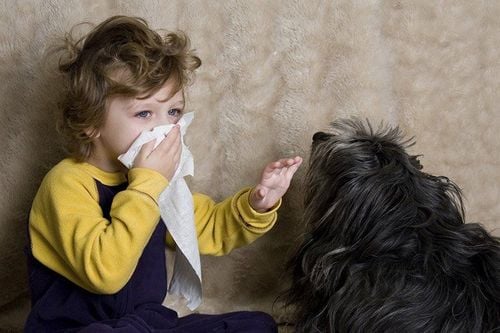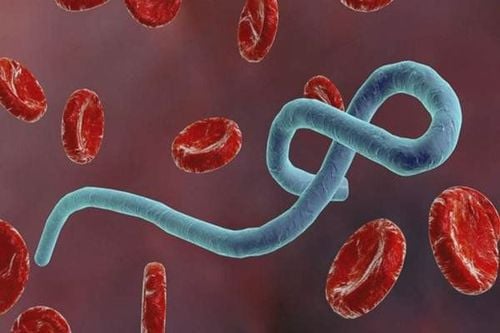This is an automatically translated article.
Translated and synthesized by Dr. Nguyen Hong Thanh - VinmecResearch Institute of Stem Cells and Gene Technology
Ebola virus disease, also known as Ebola hemorrhagic fever, is a rare but serious infectious disease that causes high mortality in humans. Frequent outbreaks occur mainly on the African continent. This virus is transmitted from wildlife to humans and spreads in the human population through human-to-human transmission.
The average Ebola virus death rate is about 50% of infections. Mortality rates have varied from 25% to 90% in previous outbreaks. Community participation is key to successful disease control.
1. Viral characteristics, origin, virulence
Ebola virus belongs to the genus Ebolavirus, capable of infecting and causing disease in humans, primates including monkeys, gorillas and chimpanzees. Several strains of the Ebolavirus family that are highly infectious in humans include Ebola, Sudan, Tai Forest and Bundibugyo viruses.
Ebola virus was first discovered in 1976 after two outbreaks of dengue fever in different countries of central Africa. The first outbreak occurred in the country of Congo, in a small village near the Ebola river. Therefore, Ebola has been named for the virus that causes this disease. The second outbreak occurred in southern Sudan, about 850 kilometers from Congo. Initially, experts in public medicine thought that these two outbreaks originated from a previously infected person who had moved between or geographical areas. However, scientists later found that these two outbreaks were caused by two strains of the Ebola virus with different genetic origins, the Zaire ebolavirus and the Sudan ebolavirus. After this discovery, scientists concluded that the virus came from two different sources, and independently spread and spread to people in each individual country.

Hình 1: Virus gây bệnh Ebola (nguồn: https://thenativeantigencompany.com)
Evidence suggests that African fruit bats are likely implicated in the spread of Ebola virus and possibly even source animals (hosts). Scientists continue to look for compelling evidence of a role for bats in the transmission of Ebola. The most recent Ebola virus to be discovered, Bombali virus was discovered from bats in the territory of Sierra Leone, West African country.
Virological and epidemiological data suggest that the Ebola virus existed long before the first two outbreaks. Conditions of dramatic human population growth, deforestation, encroachment on forest lands and the trade or eating of wild animals are responsible for the spread of the Ebola virus.
2. Signs and symptoms of Ebola patients
Symptoms may appear within 2 to 21 days after exposure to the virus, with an average of 8 to 10 days. The course of the disease usually progresses with initial symptoms such as fever, aches and pains, and then progresses to more severe symptoms such as diarrhea and vomiting.
The main signs and symptoms of Ebola usually include some or some of the following: fever, pain, and aches, such as severe headache, muscle and joint and abdominal (stomach) pain, weakness and tired. The patient then develops gastrointestinal symptoms including diarrhea and vomiting, abdominal (stomach) pain, unexplained bleeding, or bruising. Other symptoms may include red eyes, skin rash, and hiccups (late stage).
Many common illnesses can have Ebola-like symptoms, including flu, malaria or typhoid fever.

Hình 2: Dơi ăn quả châu Phi mang virus Ebola (nguồn: https://theconversation.com)
3. Route of transmission
When a person is infected with Ebola, an incubation period of 2 to 21 days is required before symptoms appear. A person can only transmit Ebola to others after they develop signs and symptoms of Ebola. In addition, the Ebola virus is not transmitted through food. However, in some parts of the world, the Ebola virus can be spread through handling and consuming wild animal meat or hunting wild animals infected with Ebola. There is no evidence that mosquitoes or other insects can transmit the Ebola virus.
During an Ebola outbreak, the virus can spread rapidly in healthcare settings (such as clinics or hospitals). Clinicians and other medical personnel providing care should use specialized medical equipment, preferably disposable. Proper cleaning and disposal of tools such as needles and syringes is important. If instruments are not disposable, they must be disinfected before being used again.
Ebola virus can survive on dry surfaces, like doorknobs and countertops for several hours; In body fluids such as blood, the virus can survive for up to several days at room temperature. Cleaning and disinfection should be done with a hospital grade disinfectant.
Risks:
Health care workers not using proper protective equipment while caring for an Ebola patient, family members or friends who are in close contact with an Ebola patient are at risk highest disease. Ebola can be spread when people come into contact with the blood or body fluids of an infected person.
However, Ebola poses little risk to travelers or the general public who do not care for or have close contact (within 1 meter) of someone with Ebola.
Persistence of the virus
The virus can survive in the body in places such as the anterior chamber of the eye, testicles and brain, after an acute infection occurs. These are sites where viruses and pathogens, such as the Ebola virus, are protected from the body's immune system, even after the body has recovered from the disease. These areas include the testes, the inside of the eye, the placenta, and the central nervous system, especially the cerebrospinal fluid. Whether the virus can survive in these body parts and for how long depends on the individual case. Scientists are now studying how long the virus lasts in these bodily fluids among Ebola survivors.
Source: WHO, CDC, FDA
MORE:
Diagnosis and treatment of Ebola virus disease according to the guidelines of the Ministry of Health Where did the Ebola outbreak occur? How is Ebola virus transmitted?














